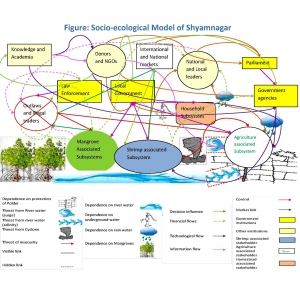Shyamnagar community sees its future through resilience lens
MFF team explores the socio-ecological system of southwest corner of Bangladesh to identify priorities for investments
Location: Shyamnagar, Satkhira, Bangladesh. 30th Apr 2013
Shyamnagar is a subdistrict of Bangladesh situated in its south west corner adjacent to the Sundarbans. It is known for its communities struggle against natuaral hazards like cyclonic surge and salinity ingress, also known as one of the largest producers of Shrimp in the country. It is one of the target areas of MFF Bangladesh for the DANIDA funded mangroves and climate chage component of MFF. MFF team anayzed the current state of resilience in Shyamnagar using a participatoy citizen consultation on the basis of socio-ecological thingking.
Shyamnagar as it is visible now is result of two large policy interventions; construction of coastal polders in 1960s and the continuation of the green revolution for the following 20 years, eventually mass extension of shrimp culture starting from 80s and continued for the following 20 years. But last and most visibly, 2009 surge caused by cyclone Aila and its aftermaths remain the most impacting event which changed everything lastingly.
It was confirmed from the field findings that the area is facing conflict issues between the fresh water dependent paddy farmers and saline water dependent shrimp farmers. There is a need for zoning for freshwater and slaine water based activities and associated management.
Most interestingly, the community is already aware of there need and efforts are ongoing on ground, what is needed is coordinated action. In every step of the analysis starting form participatory rural appraisals and key informant interviews to stakeholder group consultation, it was appericiated by the stakeholders which includes the local officials and public representative. "I never came across such a way of thinking. It is amazing to see all the social and ecological changes, impacts, ecosystem services, stakeholders and instituional responses captured in one frame. If we can use it properly, we sure can make change happen"; said the Upazilla Agicultural Extension Offcer in the closing session of the citizen plenary.
Through the resilience analysis process, citizens of Shyamnagar identified the roots of there current problems from their socio-ecological history and visioned a future 'Shonar Shyamnagar-the Golden Shyamnagar' to which they want to reach by 2050. Using the resilience lens and citizens suggestions, 24 areas were identified for MFF funding and interventions. Next step for MFF will be to focus the Bangladesh small grants facility in line with these priorities and development of a strategic action plan through advocacy with the key stakeholders and local policy makers to achieve this vision for 'Shonar Shyamnagar'.

Socio-ecological Model of Shyamnagar, Shyamnagar, Satkhira, Bangladesh © IUCN, 2013